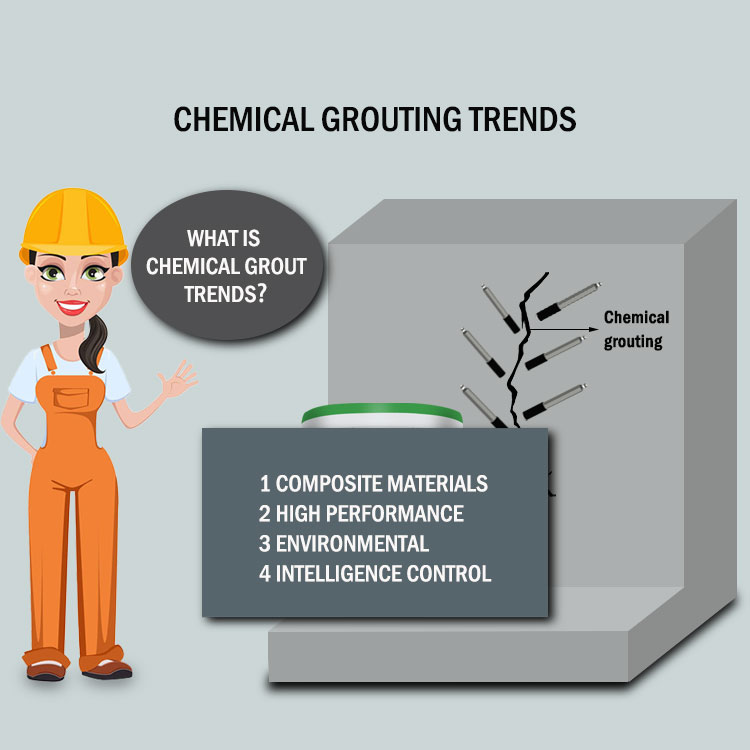What is chemical grouting?
Chemical grouting is an engineering technology that uses a grouting machine to inject chemical materials into concrete cracks or underground, which can effectively reinforce the underground rock and soil, improve its compressive strength and tensile strength.
Reasons for chemical grouting
Concrete structural defects caused by uneven foundation compaction. For example, uneven compaction may cause cracks in the base slab, or uneven settlement may change the stress state of the wall, causing cracks. These cracks can create channels for water to penetrate, leading to leaks.
Concrete's own performance fault may also cause cracking.For example, when concrete is exposed to the sun or frozen, its shrinkage may change dramatically, causing cracks in the concrete and leading to water leaks.
In general, the causes of cracking and leakage in projects may involve foundation, concrete repair materials, construction and other aspects.
In order to avoid and reduce leakage problems, strict control and management are required in all aspects such as design, construction, material selection, and maintenance. Timely chemical grouting repair can extend the service life of the project.
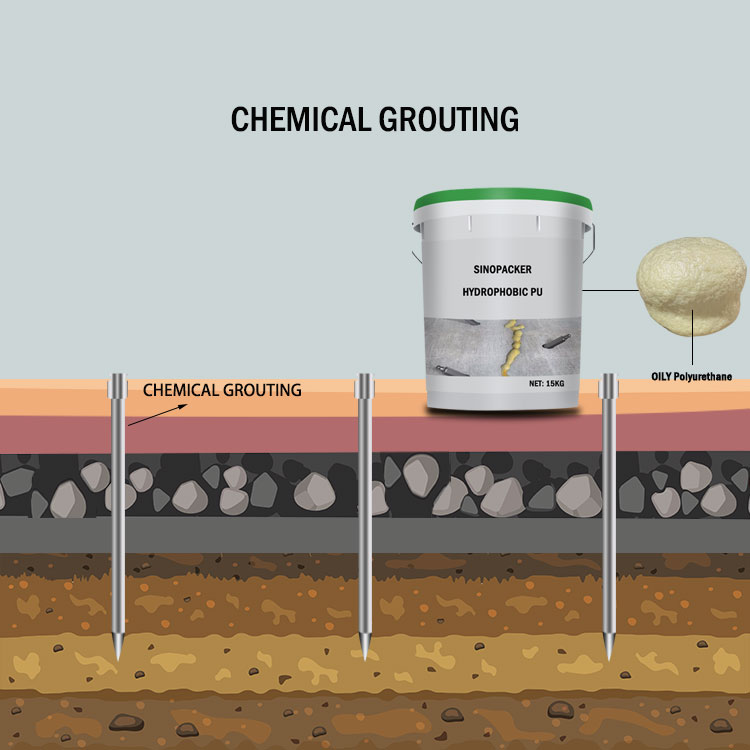
Chemical grouting brand
Chemical grouting technology is mature, with a full range of varieties, and is widely used in waterproofing projects, construction building engineering, building structure reinforcement etc.
Chemical grouting materials can penetrate into the ground through pores, cracks and gaps in rock formations, and interact with underground minerals to form a solid whole.
There are many well-known companies in the world that provide chemical grouting materials, grouting equipment and accessories.
The main grouting materials companies are: Sika, Sinopacker, BASF, Mapei, Oriental Yuhong, CKS, DOW, Euclid, Henkel, Normet, Penetron, Koster, MC, RASCOR, etc. They produce organic chemical grouting materials, inorganic grouting materials, polyurethane materials, acrylate materials, and epoxy resin.
Sinopacker company is main chemical grouting equipment and accessories supplier. Sinopacker produce various types of concrete injection packer, grouting injection machines and accessories. Click here to learn more.
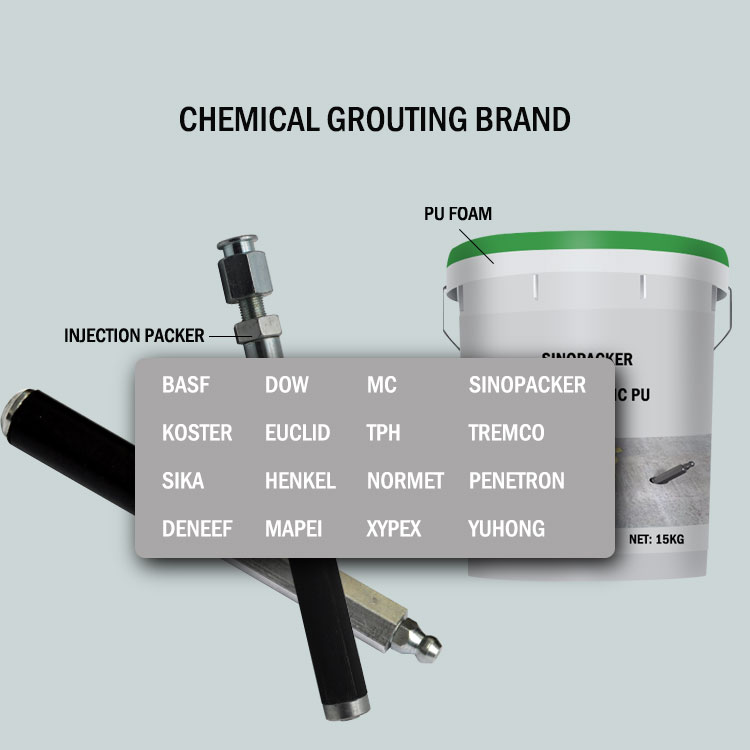
Characteristics of chemical grouting
Chemical grouting technology has the advantages of simple operation, good effect, stable and reliable. It had applied various construction fields.
Mature technology and cost save
The grouting fluid technology is mature, with complete varieties, stable quality and good effect. The comprehensive construction cost is low and the economic benefits are significant.
Environmentally friendly
The grouting materials slurry is chemically resistant, non-toxic, environmentally friendly and permanently waterproof after injection.
Simple construction and high efficiency
The construction process is simple. The construction speed is fast, and the waterproofing effect is immediate and permanent. Saving labor works and the construction efficiency is high.
High strength, high toughness and high adhesion.
With high pressure pump, the chemical grouting materials is easy to react chemically with water, then improve the construction compressive strength and achieve waterproof and leak-proof effect.
Strong durability.
Since chemical grouting materials have high durability, they can be used in underground environments for a long time. Therefore, they are widely used in infrastructure construction and geotechnical engineering.
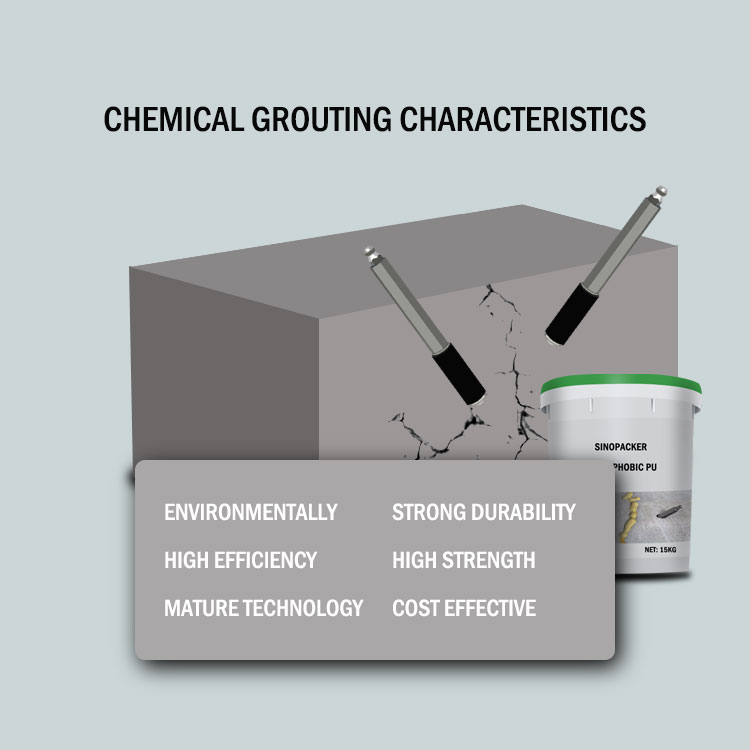
Application of chemical grouting
Chemical grouting has a wide range of applications, and its scope of application is still expanding. Here is a brief introduction:
Foundation reinforcement
Chemical grouting plays an important role in the reinforcement of building structures. For cracks or damage in concrete structures, chemical materials can be injected through the grouting packer.
Building curtain injection
Curtain injection for dams, reservoirs, culverts, bridges. Bridge foundation reinforcement and building crack reinforcement.
Underground anti leakage and penetration
Chemical grouting materials through cracks to form a barrier, effectively preventing groundwater leakage and ensuring the normal use of underground projects.
Concrete repair
Foundation reinforcement and crack reinforcement of concrete buildings and structures. For example, concrete dams, city buildings, factories, oil, gas and grain depots, etc.
waterproofing projects
Anti-seepage curtains for mines, wastewater and urban garbage dumps. Waterproofing in mine construction. Water leakage stop in drilling and drilling wall reinforcement.
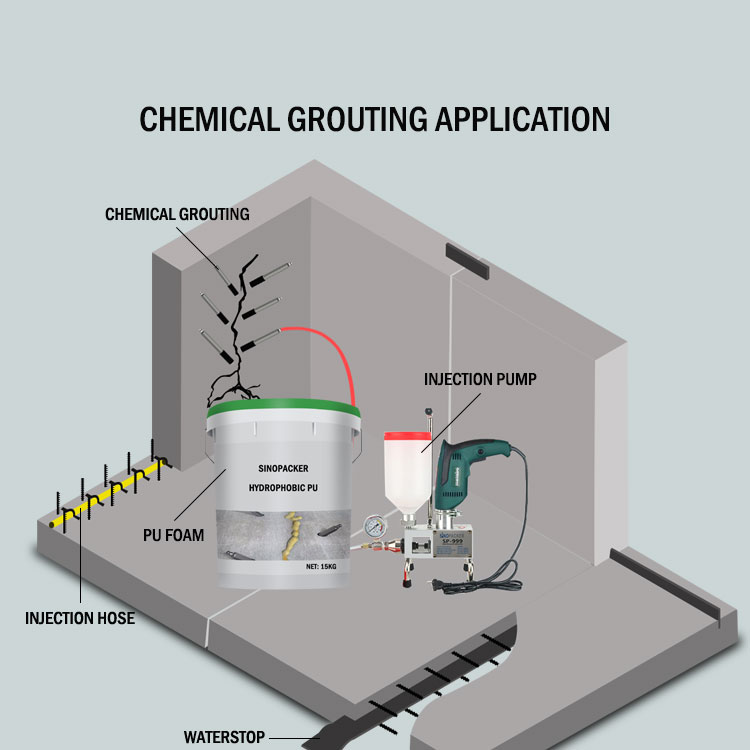
Chemical grouting materials
There are many types of chemical grouting materials, mainly acrylamide, acrylate, polyurethane, epoxy resin, methacrylate. Commonly used are polyurethane, epoxy, acrylate, water glass. Due to the low price, it is also used in some temporary projects. The following are the classifications of various chemical grouting materials.
Polyurethane chemical grouting material
Among chemical grouting materials, polyurethane grouting material is one of the most widely used varieties, and it is used in many construction projects. Polyurethane chemical grouting materials can be divided into three categories: water-soluble (hydrophilic) and oil-soluble (hydrophobic) and modified polyurethane.
Polyurethane chemical grouting materials generally is a single component. Its main component is a terminal isocyanate (NCO) prepolymer obtained by the reaction of excess diisocyanate and polyether polyol. It can also be a two-liquid type, which is composed of a prepolymer and a curing agent (and an accelerator).
Cracks and damage are inevitable in building infrastructure during use. Polyurethane grouting foam can be used to repair and reinforce infrastructure. It can restore the integrity of the structure and improve the bearing capacity and service life of the construction infrastructure.
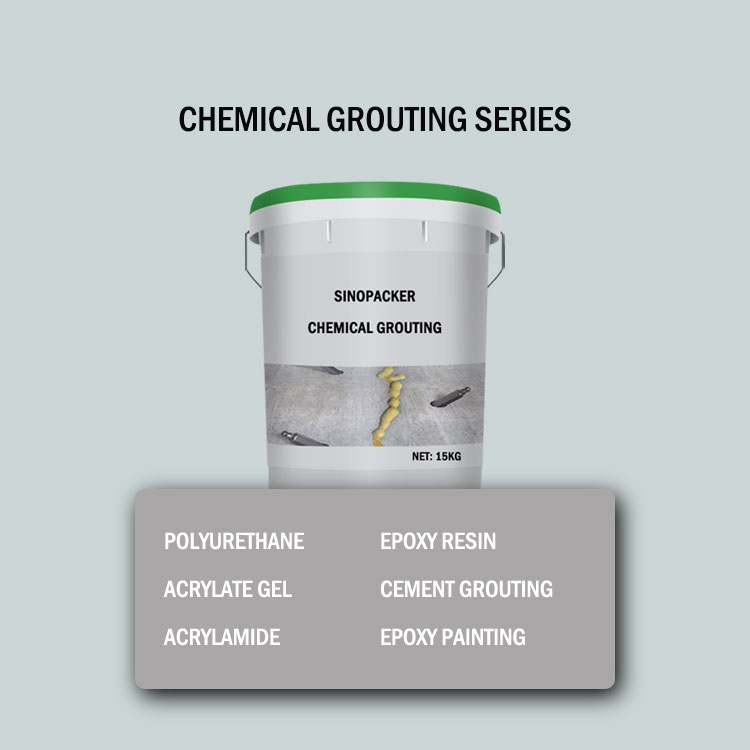
Hydrophobic polyurethane grouting
The oily hydrophobic polyurethane grouting, after reacting with water, expands rapidly to plug the cracks, achieving the purpose of water stopping and enhancing structural reinforcement.
Hydrophilic polyurethane grouting
Water-based grouting material has good hydrophilicity and is suitable for grouting and waterproofing of wet cracks. The feature of hydrophilic polyurethane foam is that it is easily dispersed in water, self-emulsifies when in contact with water, and immediately undergoes polymerization reaction.
Good elasticity, impermeability and bonding properties, no pollution to water quality after grouting.
Modified polyurethane grouting material
In order to obtain lower viscosity and higher consolidation strength, the grouting material can also adopt a mixed system by combining the advantages of several polymers, which is called modified polyurethane grouting material.
According to construction needs, hydrophilic water borne PU materials and oil-soluble hydrophobic PU can also be mixed for grouting construction. PU materials is used for grouting of small cracks, especially for the construction of water-containing gaps.
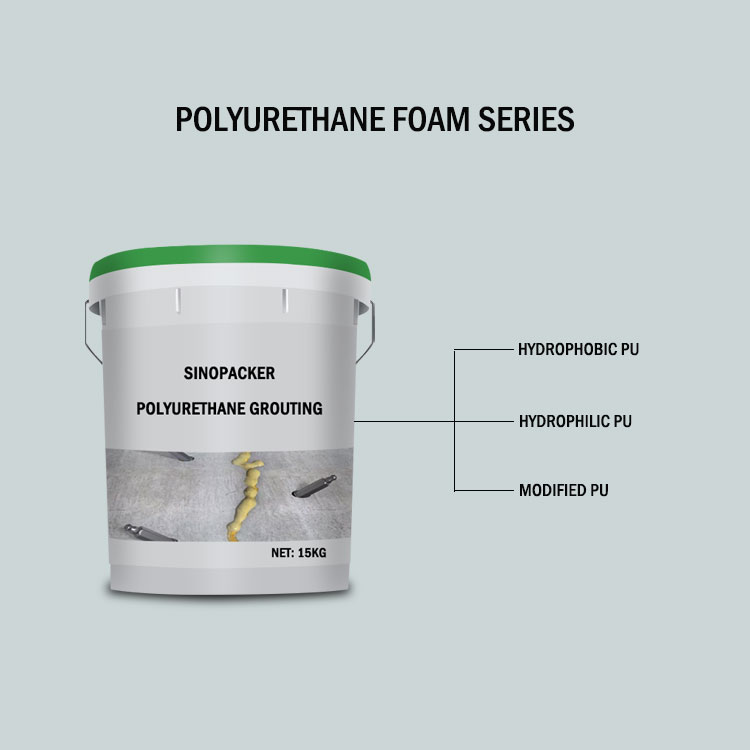
Acrylic gel grout
Acrylic gel is a polymer material made from the polymerization of vinyl acrylate. Its main components include acrylic resin, filler, curing agent. It has good anti-seepage, crack resistance, adhesion and durability.
Cement grouting materials
Cement grouting materials is a liquid made of admixtures, cement and water. Cement slurry can fill gaps and defects in building structures, improve the density and integrity of the structure.
Ultrafine cement grouting
Ultrafine cement has the advantages of high strength, good fluidity. It has good pourability, strong durability, non-toxic and tasteless. Ultrafine cement grouting materials are increasingly widely used in engineering.
Epoxy resin
Epoxy resin is a widely used chemical grouting material that uses low-viscosity resin, special curing agent and special graded filler. It is used to concrete repair.
Epoxy mortar grout
The main components of epoxy mortar grouting materials are epoxy resin, cement, dry fine sand, water, general anti-corrosion agent. After construction, it can obtain good adhesion and durability.
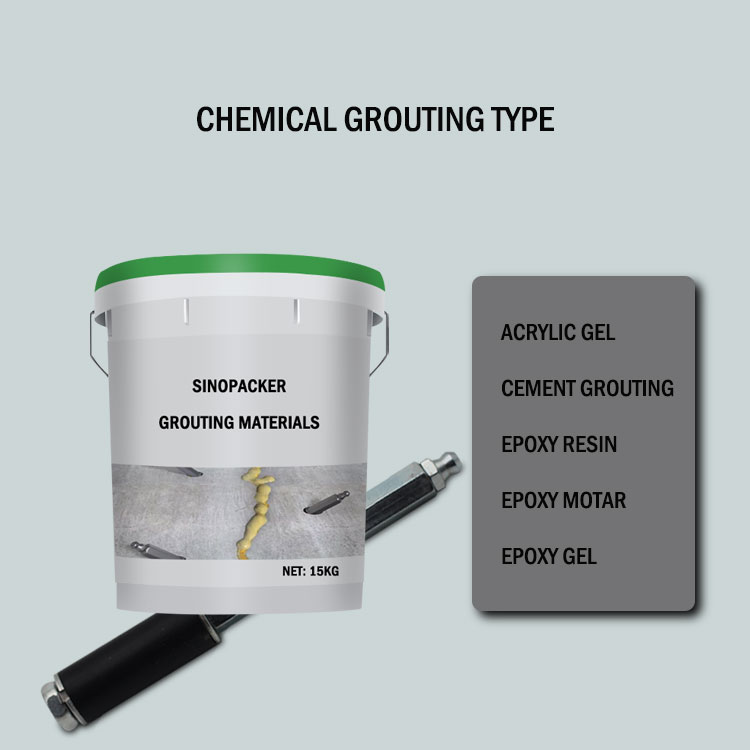
Chemical Grouting Equipment and Accessories
The main equipment includes grouting injection pump, grout injection hose, grout injection packer, etc. The high pressure injection pump should be adapted to the chemical grouting materials, and the pump should have sufficient slurry discharge and stable working performance.
High pressure grout injection pump
High pressure injection pump is a professional machine, which mainly used for structural chemical grouting. It has ultra-high pressure and stable quality, so the construction speed is very fast. The grout pump weight is 7.5 kg, which is labor-saving and easy to move.
Concrete injection packer
Grout injection packer is an important part of chemical grouting. It is used to inject chemical grouting materials such as polyurethane and epoxy resin. Concrete injection packer is cheap and widely used in various waterproof project engineering.
Grouting injection hose
Injection hose is pre-laying tube for delivery chemical grout materials. It is suitable to install injection hose between the joints of new and old concrete. When the water seeps into the joint, the chemical material can seal the construction joint.
Drill and accessories
The electric drill has the characteristics of high working pressure, fast drilling speed and simple operation. It is an indispensable auxiliary equipment for chemical grouting engineering.
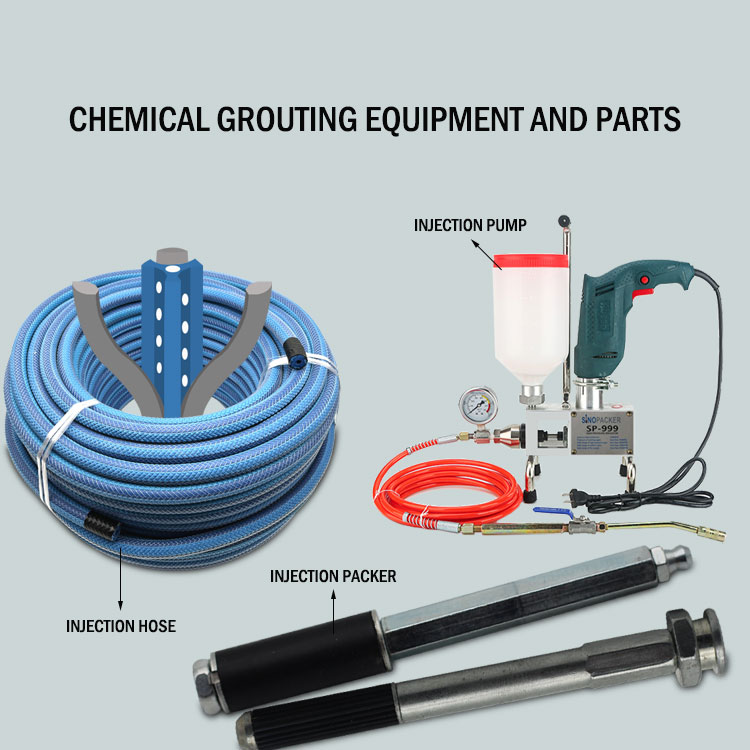
Different methods of chemical grouting
Chemical grouting has a wide range of applications, and different methods are required for different grouting construction engineering projects. The following is a sharing of grouting methods.
Penetration Grouting injection
The penetration grouting method mainly uses the permeability of chemical to inject the materials slurry into the concrete or rock crack. This method is suitable for situations where the overall performance of the material needs to be improved, such as enhancing the durability and penetration.
Curtain injection
Curtain injection is a construction project that injects chemical materials into the rock cracks, aiming to form a continuous water-blocking curtain to reduce the seepage volume and reduce the penetration pressure.
When implementing curtain grouting, it is necessary to determine the axis position, depth, thickness (number of rows) and length on the plane of the curtain.
For multi-row curtains, the general construction sequence is to drill and grout the downstream row first, then the upstream row, and finally the middle row.
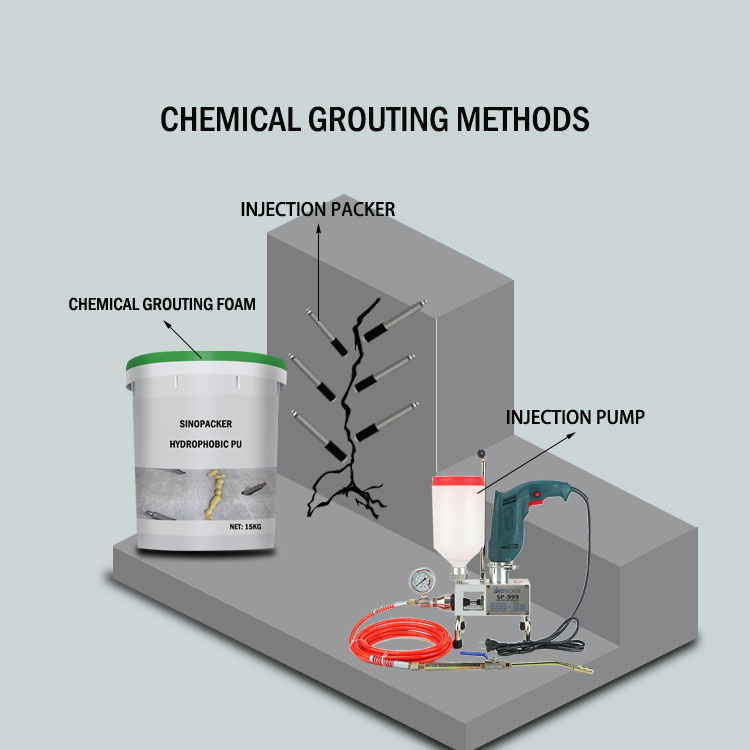
Compaction Grouting
The foundation of a dam or the surrounding rock of a tunnel has low bearing capacity. Compaction grouting can improve its integrity and bearing capacity. Therefore, this method is particularly effective for lifting and stabilizing structures.
Jet grouting
Jet grouting is a method of using the impact of high-pressure gunite jets to form a mortar solid body, which can form a continuous wall to prevent penetration seepage and strengthen the foundation.
Reinforcement grouting
When cracks appear in concrete buildings, their integrity and strength are often reduced. Chemical grouting can restore their integrity and strength.
Soil grouting
Soil grouting is the process of injecting the chemical materials into the voids in the soil, allowing the slurry to fully penetrate the surrounding soil layers to form a uniform and compact grouting body, thereby improving the strength and stability of the foundation.
Backfill grouting
The lining structure of the tunnel is not well integrated with the surrounding rock, and the lining is not evenly stressed, so backfilling grouting are required.
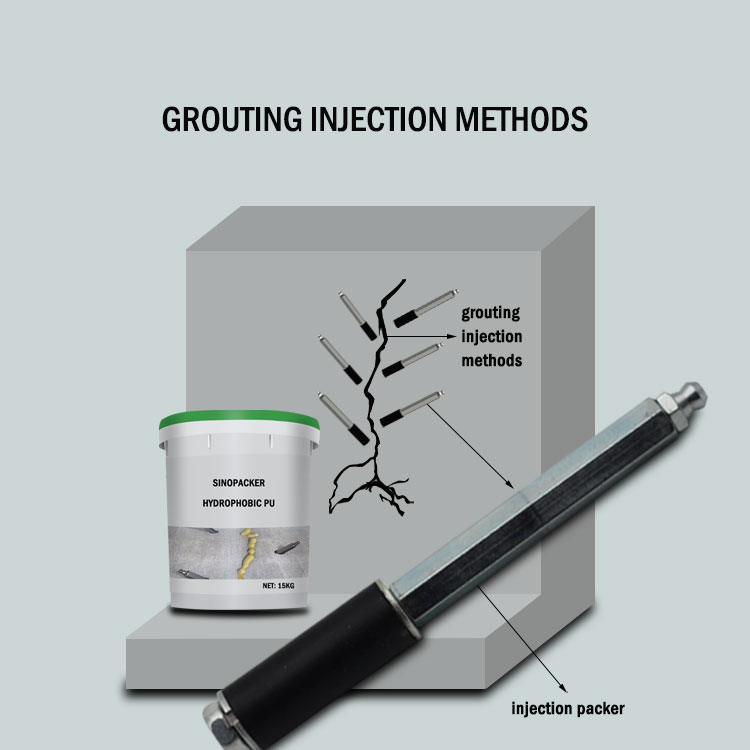
Steps of chemical grouting
Chemical grouting construction generally includes the following basic steps:
1. Measure and set out according to design drawings
The order of drilling holes is to drill the pilot hole first, and then determine the subsequent grouting holes after the water pressure test.
2. Choose the grouting material
When preparing chemical grouting materials, be sure to scientifically mix them and try to use the principle of multiple small amounts of grouting.
3. Determine the drilling position
When correcting the hole position, the drilling hole inclination deviation should generally not exceed 1/30, and the hole opening position deviation from the designed position should generally not exceed 10cm.
4. Drilling the hole and injection packer layout
Drill the hole with special drilling machines. The length of the injection packer should be determined according to the thickness of the concrete. The drilling should be 150 to 350 mm away from the crack and be carried out crosswise on both sides of the crack direction.
5. Prepare chemical grouts
Follow the manufacturer's instructions when preparing chemical grouts and make sure the solution is mixed correctly to achieve the desired consistency and properties.
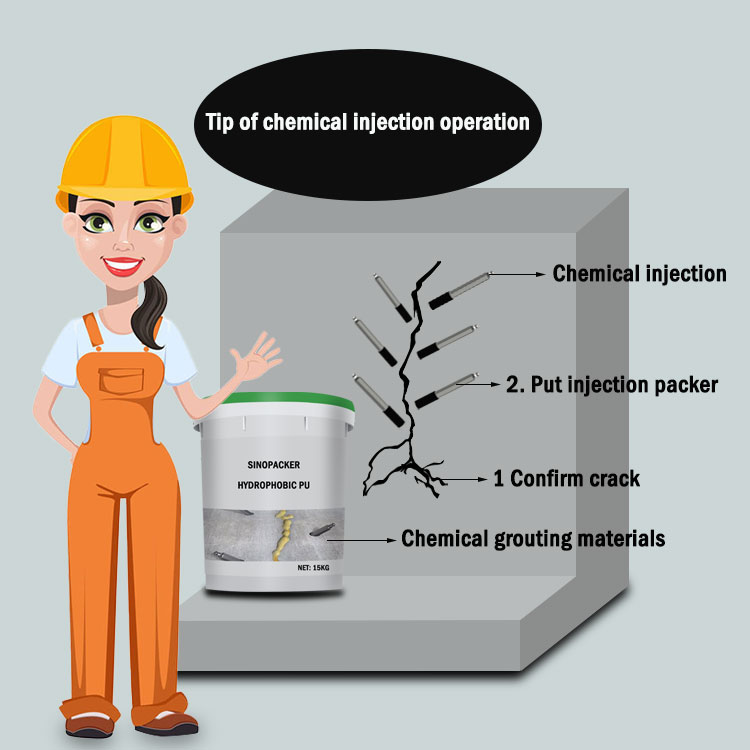
6. Chemical grouting materials injection
Connect the injection equipment to the packer to start injecting chemical materials. When grouting, the upper grouting adopts the top-down method, and the lower grouting adopts the bottom-up method.
7. Controlling grouting pressure
High grouting pressure may cause cracks to expand and destroy the original rock structure. Therefore, the grouting pressure must be controlled within a certain range.
8. Disassembling the injection packer
After grouting is completed and no leakage is confirmed, the exposed grouting packer can be removed.
9. Clean up the site
After grouting, the grouting should be closed. Use cement-based waterproof materials to repair and seal the grouting opening.
10. Quality inspection and quality assessment
The inspection holes with cracks well filled account for more than 90% of the total effective inspection holes.
11. Completion Documents
The contractor shall submit construction records, grouting results, quality inspection and testing and other acceptance documents for the completion acceptance of the drilling and grouting works in accordance with the relevant requirements and regulations.
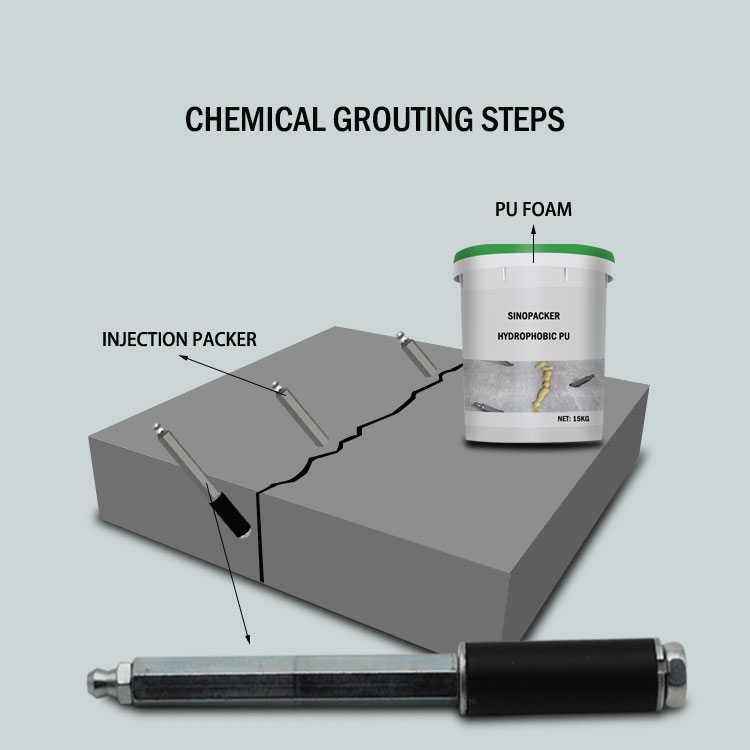
Development trends of chemical grouting
Chemical grouting materials are used in combination with other waterproof materials to improve the waterproof effect. The development trend of chemical grouting is composite materials, high performance, environmental protection and intelligence.
Composite materials: Develop new composite chemical grouting materials to improve grouting effect and durability
High performance: With better permeability, higher strength and lower shrinkage, it can better meet the engineering needs under complex geological conditions.
Environmental: With the increasing awareness of environmental protection, the development of environmentally friendly grouting materials has become an important research trend, which requires that the materials can reduce environmental pollution during production and use.
Intelligence control: Combined with modern information technology, intelligent control of the chemical grouting process can be achieved to improve construction quality and efficiency.
With the continuous advancement of technology and the expansion of application fields, the application prospects of chemical grouting technology will be broader. We look forward to seeing more technological innovations and application examples to add new vitality to the development of chemical grouting
